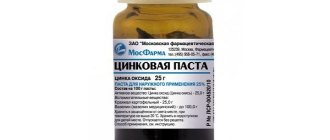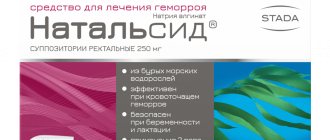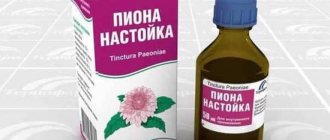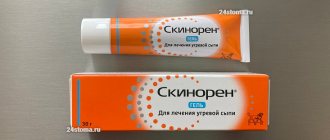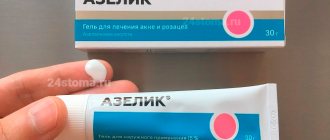Menovazin is a complex drug with a wide spectrum of therapeutic activity. It has antiseptic, antipruritic, distracting, local irritant and analgesic effects. Used to relieve pain associated with various diseases of muscles, joints and nerves. Prescribed for adults and children.
Composition and release form
The drug is available in several dosage forms:
- The solution is colorless, transparent with a pleasant menthol odor. Used for topical use. Packaged in dark glass bottles with different volumes.
- Ointment - intended for external use. Externally white, homogeneous structure with menthol aroma. Sold in aluminum tubes of 40 g and secondary cardboard packaging with attached instructions for use.
The main components of the drug are: menthol, procaine and benzocaine. Excipients: ethyl alcohol in solution and pure water, paraffin, mineral oil, emulsifier in the ointment.
Menovazin - contraindications
Although this drug is widely used, it is not suitable for everyone. In some cases it will have to be abandoned. For this reason, when trying to figure out what Menovazin helps with, we must not forget about its contraindications. The use of the medication is prohibited when:
- individual intolerance;
- tendency to develop vasospasms;
- the presence of burns and open wounds on the skin;
- acute pulmonary tuberculosis.
Some people are wondering whether Menovazine can be used during pregnancy. There is no consensus among doctors regarding the use of this medicine during pregnancy. Some experts believe that it is unsafe to use it, so Paracetamol is prescribed instead. Others recommend the drug for use by pregnant women. They base their judgments on the fact that the drug does not affect the composition of the blood, but only has a local effect.
Since Menovazin is used externally, it does not pass into breast milk (does not affect its taste and aroma). In view of this, this medication is used during lactation. However, it is recommended to put the baby to the breast only half an hour after using the medicine: by then the specific smell of the medicine will disappear. The use of Menovazin by children over 7 years of age is not prohibited. If the kids are younger, you need to be more careful with the drug.
pharmachologic effect
Menovazine is a combination drug with broad therapeutic activity. It has a clear antipruritic, analgesic, distracting, antiseptic and sedative effect.
The healing properties are due to the quality composition of the product. For example, menthol affects certain receptors that are sensitive to low temperatures. As a result, it causes a feeling of pleasant cold and relieves pain. It also affects the tone of any blood vessels, arteries and veins.
Procaine has an exclusively analgesic effect. Benzocaine causes local anesthesia without provoking vascular tone.
Menovazine - side effects
In most cases, this medicine is well tolerated by patients. Therefore, it is very important to know what Menovazin solution helps with. At any moment in life, a situation may arise when this drug is useful. However, treatment with Menovazin should be strictly carried out according to the regimen prescribed by the doctor. If this drug is abused or the frequency of its use is increased, the following side effects may occur:
- hives;
- dizziness;
- drowsiness;
- hypotension;
- general weakness;
- swelling;
- nausea;
- asthenia.
Contraindications
Absolute contraindications to the use of the drug are:
- Individual intolerance to the active or auxiliary substances of the drug.
- Violation of the integrity of the skin in the areas where the solution or ointment is supposed to be applied.
- Inflammatory skin lesions near or directly on the area where the medicine should be applied.
The drug should be prescribed with caution to women while pregnant, breastfeeding and children. In this case, increased monitoring of patients by a doctor is necessary.
What does Menovazin treat?
This drug has an analgesic effect on the area of application. In addition, it has a calming and antipruritic effect, so it can be applied to irritated areas. Due to its alcohol content, the solution is used as an antiseptic. To understand in more detail what Menovazin is used for, a detailed study of the pharmacological action of each of its components will help. The main substances of the drug have the following effects:
- Menthol
- has a mild anesthetic effect. This effect occurs due to the expansion of blood vessels close to the skin and irritation of nerve endings. After contact with the cover, it envelops it with a slight coolness. In addition, menthol is an excellent conductor for the other components of the drug: it enhances their effect. - Procaine
is an anesthetic. It blocks sodium channels. As a result, the occurrence of pain impulses is prevented. - Benzocaine
is also an anesthetic. It provides a long-lasting analgesic effect.
Thanks to this combination of main components, the excitability of neurons is inhibited and the conductivity of axons fades. All this provides a distracting effect. In other words, after applying the medicine to the problem area, the pain intensity becomes less pronounced. This effect lasts for a certain time.
Instructions for use of Menovazin
According to the instructions for use, the drug is intended for external use. Depending on the form of release, the drug has a different treatment regimen:
- Solution - rub into the affected area of the skin with smooth massage movements until completely absorbed. The frequency of use is no more than 3 times a day. The duration of the therapeutic course should not exceed 4 weeks. If necessary, the duration of use can be increased.
- Ointment - applied to the surface of the skin to relieve pain or itching. Apply maximum 3 times a day. The duration of the course depends on the type and severity of the diagnosis. The permissible therapeutic dose per day is no more than 9 g.
Menovazin - indications for use
This medication has a wide range of uses. There is even an opinion that Menovazin treats 13 diseases. Considering the pharmacological action of this drug, it is quite possible that the number of diseases that such a medicine can treat is much greater. According to the instructions, Menovazine has the following indications:
- arthralgia;
- neuralgia;
- myalgia;
- sciatica;
- radiculitis;
- hemorrhoids;
- psoriasis;
- dermatoses;
- dislocations and other mechanical damage;
- scratches and abrasions;
- colds accompanied by runny nose and cough;
- acne.
Why does pain occur with a herniated disc?
A herniated disc is a condition in which the disc has “burst”, its outer layers rupturing and the internal contents rushing out. Surprisingly, such destruction of the disc sometimes remains completely unnoticed, since cartilage does not have innervation and therefore cannot hurt. Acute pain occurs if and only if the intervertebral disc, which has disrupted its configuration through a herniated protrusion, begins to exert significant and constant pressure on the surrounding soft tissues, which contain the branches of the nerves that carry pain sensitivity.
First of all, these are the longitudinal ligaments of the spine and surrounding muscles. The participation of intervertebral segmental nerve roots is also important. It is known that each pair of roots consists of two parts: sensitive and motor. If the hernia presses or causes compression of the motor part, then lower, in the legs, movement disorders will develop: decreased tone, weakened tendon reflexes, muscle weakness and peripheral paresis, which in severe cases turns into complete paralysis.
If the hernia compresses the sensitive part of the root, which carries information for analysis to the central nervous system, then various sensitivity disorders are possible. These are paresthesia, numbness, crawling, and, of course, pain. After all, pain is also one of the types of specific sensitivity. Read more about sensory disorders with lumbar hernia here. By squeezing the nerve root, the hernia causes swelling, which then itself becomes a source of compression of the nerve tissue and causes persistent back pain for several days.
Finally, the third component is the reaction of the surrounding muscle tissue, when the muscles also spasm, tighten and cause already aching, constant back pain that lasts many days, weeks, and even months. It is this pain that “office workers” are very familiar with. Without any hernia, due to low motor activity, their muscles are in a state of hypoxia and spasm.
How can Menovazin improve the condition of a patient with the occurrence or exacerbation of a hernia of the lumbar spine? What parts of pain does it affect? But before we talk about this, a few words about the drug itself.
Similar drugs
Surprisingly, Menovazin has practically no analogues. There are ointments and creams with a cooling effect, for example, Ben-gay, which is prescribed for sports injuries, bruises, sprains and dislocations. But there is no exact recipe yet, when the alcohol solution contains menthol and anesthetics. There is a separate solution of lidocaine in the form of a spray, useful for injuries and wounds for the purpose of pain relief, in dentistry, but its cost is several times higher, up to 300 rubles.
Therefore, Menovazin can be considered an extremely successful, cheap combination for the symptomatic treatment of lesions of the musculoskeletal system, including pain syndrome due to hernias of the lumbar spine.
But, nevertheless, with some skill, you can make an analogue of Menovazin at home, for example, using the same alcohol or vegetable oil. In the second case, for nine parts of neutral vegetable oil, at least sunflower, take 1 part of peppermint essential oil. The resulting substance will also cool and distract, especially with low-intensity back pain. If you have pure medical alcohol, then you can add liquid menthol extract to it in the proportion given at the beginning of the article, and release the contents of one ampoule of novocaine, which is sold in a pharmacy. As a result, you will get a similar product.
Menovazin
Menovazin (menthol + benzocaine + procaine) is a combined local anesthetic. When applied to the skin and epithelial layer of mucous membranes, it irritates nerve endings and has a vasodilating effect on surface capillaries, which is accompanied by a slight tingling, burning and feeling of cold. Used for neuralgia (pain caused by disorders of peripheral nerves), myalgia (spontaneous muscle pain), arthralgia (joint pain) and pruritic dermatoses (neurodermatoses). All of the above diseases have common features: mild local inflammation or its complete absence, as well as involvement of peripheral nerves in the pathological process. Causing constant pain or, in the case of pruritic dermatosis, itching of the skin, they significantly affect the psycho-emotional state of the patient, contributing to the development of depression and negatively affecting the quality of life. Protocols for providing medical care for these diseases involve eliminating the causes underlying the disease, as well as relieving its symptoms - pain and unbearable skin itching. Various analgesic and antipruritic drugs, physiotherapy and reflexology are used. As clinical experience in the treatment of these diseases shows, a positive effect can be achieved through the use of local preparations containing menthol. This secondary metabolite, extracted from peppermint essential oils or obtained in the laboratory, is a mild local anesthetic and disinfectant that affects the cold receptors of the skin and mucous membranes. In Europe it has been used medicinally since the late 18th century. Equally effective is procaine (novocaine), synthesized at the beginning of the 20th century and since then widely used in medicine as a local anesthetic with a moderate effect. It realizes its effects by blocking sodium channels, inhibiting the process of generation of nerve impulses in the endings of afferent neurons and preventing their conduction along the long processes of neurons.
It does not affect the resting potential of nerve cells. Benzocaine, synthesized in 1890, is another effective topical therapy tool. In its action it is close to procaine. All these active ingredients are included in various drugs, but only in Menovazin (if you do not take into account extemporaneous prescriptions made in pharmacies) are they all brought together. The pleasantly invigorating freshness of menthol gives Menovazin an antipruritic effect, which is in demand for itchy dermatoses, and also as a distraction for insect bites. Tested for centuries, menthol, procaine and benzocaine potentiate each other’s effects and alleviate the condition of patients with neuralgia, myalgia, arthralgia, and back pain. Non-steroidal anti-inflammatory drugs eliminate, first of all, the inflammatory process, only indirectly relieving pain. But it is precisely by the intensity of pain relief that doctors and their patients evaluate the usefulness of a particular drug. A powerful combination of two painkillers (procaine + benzocaine) and a local anesthetic (menthol) makes it possible to use Menovazin as an emergency remedy for muscle and joint pain, being an indispensable tool in the home first aid kit.
The drug is applied over the affected area of the skin or directly onto the affected area in an even layer and gently rubbed into the skin. Frequency of use – 2-3 times a day. The duration of the medication course is determined by the doctor depending on the effectiveness of the treatment and is, as a rule, no more than one month. The number of courses of pharmacotherapy is unlimited. The drug is well tolerated and, when used in recommended doses, has a minimum of unwanted side effects, including exclusively local ones - allergies and contact dermatitis. Use during pregnancy and lactation has not been studied, so in these cases the drug should be used with caution.
